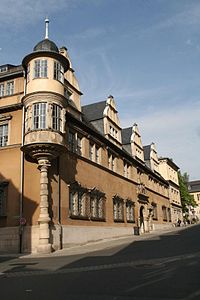
Saxe-Coburg and Gotha, or Saxe-Coburg-Gotha, was an Ernestine duchy in Thuringia ruled by a branch of the House of Wettin, consisting of territories in the present-day states of Thuringia and Bavaria in Germany. It lasted from 1826 to 1918. In November 1918, Charles Edward, Duke of Saxe-Coburg and Gotha, was forced to abdicate. In 1920, the northern part of the duchy was merged with six other Thuringian free states to form the Free State of Thuringia: Saxe-Weimar-Eisenach, Saxe-Altenburg and Saxe-Meiningen, Schwarzburg-Rudolstadt and Schwarzburg-Sondershausen, as well as the People's State of Reuss. The southern part of the duchy, as southernmost of the Thuringian states, was the only one which, after a referendum, became part of the Free State of Bavaria.
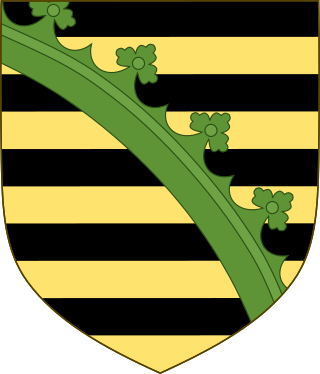
The House of Wettin was a dynasty of German kings, prince-electors, dukes, and counts that once ruled territories in the present-day German states of Saxony, Saxony-Anhalt and Thuringia. The dynasty is one of the oldest in Europe, and its origins can be traced back to the town of Wettin, Saxony-Anhalt. The Wettins gradually rose to power within the Holy Roman Empire. Members of the family became the rulers of several medieval states, starting with the Saxon Eastern March in 1030. Other states they gained were Meissen in 1089, Thuringia in 1263, and Saxony in 1423. These areas cover large parts of Central Germany as a cultural area of Germany.

Saxe-Coburg was a duchy held by the Ernestine branch of the Wettin dynasty in today's Bavaria, Germany.

Coburg is a town located on the Itz river in the Upper Franconia region of Bavaria, Germany. Long part of one of the Thuringian states of the Wettin line, it joined Bavaria by popular vote only in 1920. Until the revolution of 1918, it was one of the capitals of the Duchy of Saxe-Coburg and Gotha and the Duchy of Saxe-Coburg-Saalfeld.
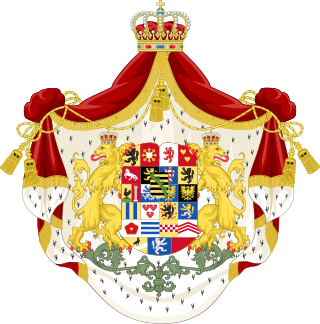
The House of Saxe-Coburg and Gotha is a European royal house. It takes its name from its oldest domain, the Ernestine duchy of Saxe-Coburg and Gotha, and its members later sat on the thrones of Belgium, Bulgaria, Portugal, and the United Kingdom and its dominions.

Saxe-Coburg-Saalfeld was one of the Saxon Duchies held by the Ernestine line of the Wettin Dynasty. Established in 1699, the Saxe-Coburg-Saalfield line lasted until the reshuffle of the Ernestine territories that occurred following the extinction of the Saxe-Gotha line in 1825, in which the Saxe-Coburg-Saalfeld line received Gotha, but lost Saalfeld to Saxe-Meiningen.

The Saxon State and University Library Dresden, abbreviated SLUB Dresden, is located in Dresden, Germany. It is both the regional library for the German State of Saxony as well as the academic library for the Dresden University of Technology. It was created in 1996 through the merger of the Saxon State Library (SLB) and the University Library Dresden (UB). The seemingly redundant name is to show that the library brings both these institutional traditions together.
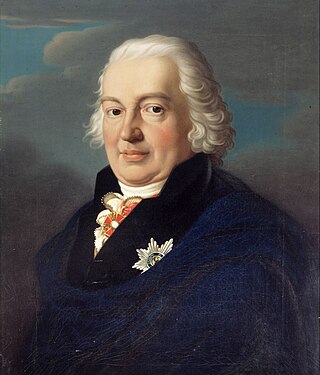
Francis, Duke of Saxe-Coburg-Saalfeld, was one of the ruling Thuringian dukes of the House of Wettin. As progenitor of a line of Coburg princes who, in the 19th and 20th centuries, ascended the thrones of several European realms, he is a patrilineal ancestor of the royal houses of Belgium and Bulgaria, as well as of several queens consort and empress consort of Mexico in the 1860s.

John Casimir of Saxe-Coburg was the Duke of Saxe-Coburg. He was the descendant of the Ernestine branch of the House of Wettin. Under his rule, the residence town of Coburg prospered with many Renaissance buildings being erected that still remain today.

Schloss Rosenau, called in English The Rosenau or Rosenau Palace, is a former castle, converted into a ducal country house, near the town of Rödental, formerly in Saxe-Coburg, now lying in Bavaria, Germany.

Ehrenburg Palace is a palace in Coburg, Franconia, Germany. It served as the main Coburg residence for the ruling princes from the 1540s until 1918. The palace's exterior today mostly reflects Gothic Revival style.
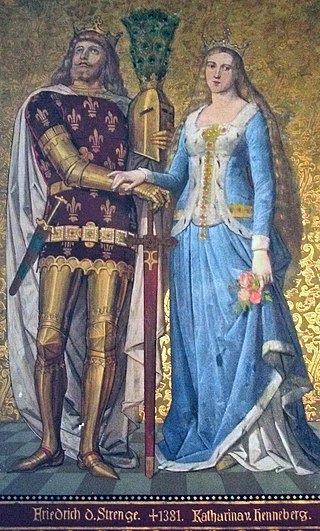
Catherine of Henneberg was a Countess of Henneberg by birth and from 1347 by marriage Margravine of Meissen, Landgravine of Thuringia, etc. She was the wife of Margrave Frederick the Severe of Meissen. Via her, the House of Wettin inherited her father's Franconian possessions.

Landestheater Coburg is a medium-sized three-division theatre in Coburg, Bavaria, Germany. Located on Schlossplatz, a central square, the Neoclassical building has 550 seats. In 2008, the theatre employed 250 permanent staff and 100 part-time employees.

The Veste Coburg is one of the best-preserved medieval fortresses of Germany. It is situated on a hill above the town of Coburg, in the Upper Franconia region of Bavaria.

Schloss Ketschendorf is a Gothic Revival residence, located in Ketschendorf, at the foot of the Buchberg, in the town of Coburg, in the state of Bavaria, Germany.

Nikolaus Gromann was an architect of the German Renaissance who served at the court of John Frederick I, Elector of Saxony. He also worked for John Frederick's descendants residing in the cities of Weimar, Gotha and Altenburg, thus spending more than 30 years in the service of the House of Wettin.
Johann Stegner was a German politician from the Social Democratic Party of Germany (SPD).

The Free State of Coburg emerged from the Duchy of Saxe-Coburg and Gotha at the end of the First World War. It existed from November 1918 until its union with the Free State of Bavaria on 1 July 1920.
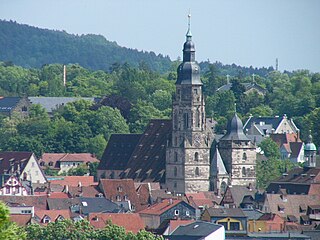
Morizkirche is a Protestant church dedicated to Saint Maurice in Coburg, Bavaria, Germany, and is the town's oldest church. Its earliest remaining structures date back to the 14th century, which superseded a church from the 12th century. Martin Luther is known to have given several sermons there in 1530 A.D. This church currently houses the family tomb of the Dukes of Coburg. In modern times, Morizkirche serves as the main church for the congregation of St. Moriz. Due to the height of its towers, the church is one of the landmarks of Coburg. It is also one of the most important Luther memorial sites in southern Germany.
